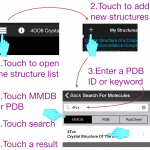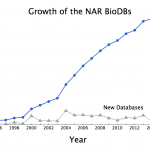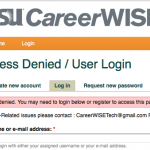web resources
We've been fans of the Molecule of the Month series by David Goodsell, for many years. Not only is Dr. Goodsell a talented artist but he writes very clear descriptions of the ways molecules like proteins, RNA, and DNA work together and function inside a cell.
To learn about proteins and their activities, I like to go directly to the Molecule of the Month page, where I can find a list of articles organized by molecule type and name. Many of these articles can also be downloaded in a PDF format.
A really nice of his articles is that he includes PDB IDs for all the…
Something interesting happened in 2014. The total number of databases that Nucleic Acids Research (NAR) tracks dropped by three databases!
What happened? Did people quit making databases? No. This year, the "dead" databases (links no longer valid) outnumber the new ones. To celebrate Digital World Biology's release of Molecule World I'll discuss some of the new structure databases below. But first, the numbers.
As summarized in the database issue's introduction, Galperin, Rigden, and Fernández-Suárez tell us this year's issue has 172 papers. 56 of those…
Wired Campus shared an interesting story this morning about a career site for female science / engineering professionals. The site is called ASU CareerWISE and its mission is to help women with problem solving.
I like the idea and I like that they built the site in Drupal, since I've become a big Drupal fan over the past year, but I think they've missed the point in a big way.
You see, every link on the front page leads me to this:
Now, I could be wrong, and I do understand the need for password protection in sensitive matters, but if I were looking for help with problem solving, and I…
Jonathan Eisen (@phylogenomics) shared this wonderful Lady Gaga lab spoof on Twitter the other day. It rocks.
And, it makes me wonder if my pals who've been thinking about getting students interested in careers by having scientists talk on camera might be going at this the wrong way. Sure, videos of scientists talking are totally fascinating (yawn..) and...
Oh right, where was I?
Well, here's the thing. If you want to get kids interested in something, you have to use something that interests them. Your strategy isn't going to work unless the kids find it intriguing enough to go watch…
Next Saturday afternoon, at ScienceOnline2010, the science goddess, the chemspider, and I will be presenting a workshop on getting students involved in citizen science.
In preparation, I'm compiling a set of links to projects that involve students in citizen science. If you know of any good citizen science efforts, please share them in the comments.
Here we go!
Before I start listing links, I am limiting this list to projects that allow both students and citizen scientists to participate. I know of plenty of student projects, where students can isolate phage and annotate their genomes or…
Liveblogging from the Hi-Tec conference
I'm currently at the Hi-Tec conference in Scottsdale, Arizona. (If you follow me on Twitter - www.twitter.com/@digitalbio - you may have seen me complaining about the temperature). It's an interesting conference, so I'm going to share some of the things that I'm learning.
Dr. Travis Benanti and Dr. Steve Fonash from Penn State University are presenting an interesting session this morning on nanotechnology.
Luckily, you don't have to know anything about nanotechnology to find the session fascinating.
If you're interested in learning about nanotechnology…
We'll have a blast, I promise! But there's one little thing we need to discuss first...
I want to explain why I'm going to use nucleotide sequences for the blast search. (I used protein the other day). It's not just because someone told me too, there is a solid rational reason for this.
The reason is the redundancy in the genetic code.
Okay, that probably didn't make any sense to those of you who didn't already know the answer. Here it is.
The picture above shows the human genetic code (there are at least 16 variations on this, but that's another story). Each middle cell in the…
Last night, the phone rang at 9:22 pm. I quickly glanced at the caller ID. Hmmm. Why is the Seattle School district calling us at this time of night?
Apparently the swine flu has come to Seattle and the school district thought we should know.
Those messages are helpful if you're a parent, but they don't tell much about the rest of the world.
Health Map is a really wonderful, user-friendly, resource for following the epidemic.
When you get to Health Map , choose Select None to clear the map.
Then select Swine Flu.
You'll see a Google map with markers representing reports. The colors show…
This is a video that a friend made that shows, very clearly, how to pour an agarose gel, load the samples and run it. I especially like the way he used a bit of time lapse photography to show the dyes separating as the gel ran.
My husband brought this fantastic book home from the ASHG* that I think many of you will find interesting.
The book is: Making the Right Moves A Practical Guide to Scientific Management for Postdocs and New Faculty, published in 2006 by the Burroughs Wellcome Fund and the Howard Hughes Medical Institute.
You can download the book for free at the HHMI site and there's even a video of Tom Cech.
In fact, this book has such great information, that if it weren't for the interesting discussions in the comment section, I truly think this book would put Drug Monkey Comrade PhysioProf, and Isis…
Teachertube looks and works much like YouTube, but you're much less likely to run across videos that Not Safe For the Classroom.
All of these videos are made by students and teachers. According to the Dallas News, there are 54,000 videos on the site already and 800,00 visitors every day.
I especially enjoyed watching Abbot and Costello doing math problems.
There's no question that the ability to work with information is one that will be required and valued for a long time to come. I think it's imperative for teachers to have students practice this skill whenever an opportunity comes about. The problem for many teachers is finding the time to identify good data sets.
MRSA stands for Methicillin-resistant Staphylococcus aureus (MRSA), a serious problem for hospital patients. Six of out seven people who become infected with MRSA, get it from some kind of health-care facility. In 2007, the CDC issued a report claiming that 18,000 people die every…
If you're going to create a new life form (even if it's only digital), Sunday Saturday seems like the best day to give it a try.
Reposted from an earlier year.
Build-A-Virus is a quick, fun, and simple game that was created and put on-line by Bioreliance, now owned by Invitrogen. This game is lots of fun, even when your students are college instructors.
In this activity, you create a new virus by picking different physical characteristics.
The game works like this:
First, you choose whether the virus has an envelope or not.
Next, you choose whether the genome is single or double-…
It was a wet and rainy day yesterday, and we have a dissecting microscope, so I decided to see if I could find some tardigrades.
Tardigrade photo by nebarnix
Reposted from Nov. 2006
I went outside and scraped a bit of moss and some lichens off of our deck. Then I put the lichens and moss in a dish. We don't have distilled water in our house, so I added a bit of cool some tap water to the dish. I squeezed the moss and lichens in the water. Then I took a pipette and transferred a bit of the stuff in the water to a plastic petri dish and looked for tardigrades.
Sure enough, I saw one…
What happens when a group of streptococci stick to cells in your throat and start to make toxins?
Your body fights back by making clones.
The animated video, Fighting Infection by Clonal Selection, from Etsuko Uno and Drew Berry is so good that if I didn't know better, I would almost think it's really capturing clonal selection on film.
What is clonal selection?
We call this process "clonal selection" because only some lucky cells get selected for cloning. These cells have proteins on their surface that are able bind to bits of stuff from bacteria or viruses. We call that stuff "antigens…
The Galápagos islands rank high on my list of places that I really, really, really want to visit. But for many reasons, it's always looked like a trip to the Galápagos would be at least a decade or two away.
Now, I'll be able to go in January and so will all of you.
Thanks to the University of Cincinnati, we'll be able to follow in Darwin's historic steps, and experience some of his amazing journey.
The only difference is we'll do this trip as avatars in Second Life.
The University is stocking this intriguing exhibit with photos and images from the Galápagos, as part of a 150 year…
Sometimes words fail me. Luckily, we have videos.
Many of you have probably read about Roger Tsien receiving the Nobel Prize this work for his work with the green fluorescent protein (GFP), but I bet some of you are wondering, why a jellyfish protein is worth a Noble Prize.
I think one of the best places to see why GFP is important, and also to see what some scientists do during the day, is JOVE, the Journal of Visualized Experiments.
The wonderful video, that's shown in this image, describes a new method for investigating Parkinson's disease. This is the kind of biological work that we…
HealthMap is a great site that could be an excellent resource when teaching a biology, microbiology, or health class. Not to mention, I can picture people using it before they travel somewhere or even just for fun.
I learned about HealthMap awhile ago from Mike the Mad Biologist, but I didn't get time to play with the site until today.
Here's an example to see how it works.
How do I use HealthMap?
I begin using HealthMap by changing the number of diseases selected to "none."
Then I scrolled through the list until I found something interesting. I chose "Poisoning." The number of…
One time, I suggested in a list-serve that science teachers make more use of primary scientific literature. Naturally, I learned all the reasons why teachers don't do this-lack of access being one of the biggies- but I also learned something surprising.
One teacher wrote that she re-writes a lot of research articles to make them easier for her students to read. I can understand that notion, in principle. My students struggle with scientific language, too, even those that have bachelor's degrees in biology.
What surprised me was thinking about the amount of time that activity would take!…
Do mosquitoes get the mumps? Part V. A general method for finding interesting things in GenBank
This is the last in a five part series on an unexpected discovery of a paramyxovirus in mosquitoes and a general method for finding other interesting things.
In this last part, I discuss a general method for finding novel things in GenBank and how this kind of project could be a good sort of discovery, inquiry-based project for biology, microbiology, or bioinformatics students.
I. The back story from the genome record
II. What do the mumps proteins do? And how do we find out?
III.…




